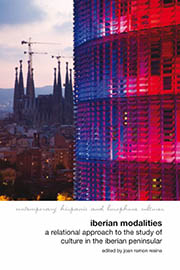Book contents
- Frontmatter
- Contents
- Preface
- List of Contributors
- Introduction: Iberian Modalities: The Logic of an Intercultural Field
- Part I Institutionalizing Iberian Studies: A Change of Paradigm
- Part II Theorizing Iberia
- Part III Iberian Dialogs
- 8 Asymmetry and the Political: Paradigms for a Cultural History of the Iberian Twentieth Century
- 9 Sins of the Flesh: Bullfighting as a Model of Power
- 10 Jews and Jewishness in Carme Riera's Dins el darrer blau
- 11 Mediterranean Exemplarities: The Case of Medieval Iberia
- Part IV From Sea to Iberian Sea
- Works Cited
- Index
9 - Sins of the Flesh: Bullfighting as a Model of Power
from Part III - Iberian Dialogs
- Frontmatter
- Contents
- Preface
- List of Contributors
- Introduction: Iberian Modalities: The Logic of an Intercultural Field
- Part I Institutionalizing Iberian Studies: A Change of Paradigm
- Part II Theorizing Iberia
- Part III Iberian Dialogs
- 8 Asymmetry and the Political: Paradigms for a Cultural History of the Iberian Twentieth Century
- 9 Sins of the Flesh: Bullfighting as a Model of Power
- 10 Jews and Jewishness in Carme Riera's Dins el darrer blau
- 11 Mediterranean Exemplarities: The Case of Medieval Iberia
- Part IV From Sea to Iberian Sea
- Works Cited
- Index
Summary
Durs càstigs eren conservats en sí mbols vells.
– Salvador Espriu, Setmana SantaThe ancient Roman geographer Strabo is best known, within Iberian studies, as being the source of the infamous comparison of Hispania to a bull's hide. As with most quotations taken out of context, Strabo's original source bears more complexity than is revealed by common discourse. Using a more precise translation, Strabo actually writes that Spain (and he certainly means Hispania) resembles an ox hide, just as Sicily is akin to a triangle and the Peloponnese to a plane-leaf (128). Strabo, more importantly, argues that a totalizing image of a landmass is not at all the ideal manner by which to derive information through geographical inquiry. He writes, just a few lines earlier, that when gleaning geographical detail it is best to separate territories into limbs: “the best way to define a country is by the rivers, mountains, or sea; also, where possible, by the nation or nations [who inhabit it], and by its size and configuration” (127). With respect to epistemology, therefore, one is encouraged to deconstruct a landmass limb by limb, with special attention paid to the configuration of the individual geographical and sociological parts, rather than drawing conclusions from an all-encompassing, macro perspective.
Whatever was Strabo's intent, that bullfighting is commonly referred to as Spain's fiesta nacional points toward the indisputable fact that the bull has become a symbol widely contextualized within Spanish literature, art, and cinema as a kind of totemic identity image that is imbued with qualities meant to describe, affirm, and at times reject national character.
- Type
- Chapter
- Information
- Iberian ModalitiesA Relational Approach to the Study of Culture in the Iberian Peninsula, pp. 143 - 161Publisher: Liverpool University PressPrint publication year: 2013



